Farewell visit to James David’s Austin garden, part 1
James and Gary’s entry garden, a gravel garden featuring agaves, aloes, succulents, and other dry-adapted plants from around the world
After 36 years devoted to creating an extravagantly plant-rich, terraced, one-of-a-kind garden on two acres in Austin’s Rollingwood neighborhood, landscape architect James David and his partner Gary Peese are leaving it all behind. Their home — an elegant, contemporary hideaway with a detached, modern concrete studio — is on the market, and they’ve already begun work on a new home and garden in Santa Fe, New Mexico.
Entry garden, with a fringe of Cupressus funebris, aka Chinese weeping cypress (I think), framing the scene
I was invited to visit in late March, when the live oaks were alight with new chartreuse leaves and the Texas mountain laurels were dripping with fragrant blossoms. James gave me a tour of the garden, rattling off botanical names so fast I caught only a few of them, and then invited me into his studio for a brief interview about leaving the garden.
Arbor made of crisscrossing steel pipes with concrete posts, to the left of the entry garden
He told me he is 71 and ready for a new adventure, cooler weather, and a smaller garden. He and Gary have already spent two summers in Santa Fe, remodeling two houses and making plans to build a house on a vacant lot they purchased. Their future garden is, for now, mainly wildflowers, said James.
Shrimp plant (Justicia brandegeana) blooms around the patio, but the largely evergreen garden screens the nearby road from view
I imagine Santa Fe, which recently opened a new botanical garden, will be very happy to have them. Their departure will be Austin’s loss. James and Gary’s influence on the gardening scene in Austin is huge. For nearly three decades they owned and operated the iconic garden shop and boutique nursery Gardens (now closed) and David/Peese Design, a garden design studio that’s given many well regarded designers in Austin and beyond their early training.
James has also served for many years as chairman of the Garden Conservancy’s Open Days program and has opened his own garden to the public many times. I’ve posted about my Open Days visits twice, in October 2006 and October 2010. Thanks to James and Gary’s generosity, attendees of the inaugural Garden Bloggers Fling enjoyed a private tour in 2008.
White irises mark the final resting place of four of James and Gary’s pet cats
Since I’ve never gardened anywhere longer than 7 years, I can hardly fathom the depth of garden making that goes into a 36-year-old garden. James is the primary designer and gardener. (Gary told me he is more of a vegetable gardener, tending the kitchen gardens near the house.) James’s avidity for new and different plants — “if you love the plant you’ll find a place for it,” he declared in a Martha Stewart video about his garden — is reined in by a classic approach to design.
Boxwood pruned into an embroidery of loops and curves
Evergreen hedges, strong hardscape structure, formal axes that lead the eye and focal points that arrest it — these elements create compelling views from inside the home, lead one on a journey of discovery along numerous tempting paths, and provide multiple places to stop and enjoy the garden.
Let’s follow a few of the paths together, starting here at street level and working our way around the house, down to the lowest level of the back garden, and back up. This formal parterre garden along the street…
…is accessed on one end via a curving, shallow stair. At its foot, an olive jar and round stones attract the eye amid evergreen shrubs.
An especially dark purple Texas mountain laurel (Sephora secundiflora) caught my eye here.
In the shade, tall stems of blue flowers reminded me of English bluebells. Could these be Spanish bluebells (Hyacinthoides hispanica)?
A very narrow path leads from the olive jar through a plane of clipped boxwood (a substitute for a lawn’s negative space, James told me) toward a side patio on the house. I find this path a bit narrow for comfort, but James said he enjoys the feeling of moving through the plants. Maybe if you have a man’s narrow hips? I sidled through.
Stopping at the patio and looking back toward the olive jar, the view is entrancing. Those leading lines…
…they work to pull you in multiple directions.
Let’s head back to the entry garden…
…to admire those gorgeous agaves again. Aloes were blooming too.
Visitors are immersed in the garden before they even reach the front door.
The front door is sheltered under a narrow porch and set modestly to one side.
A patchwork of paving materials imposes a linear design on the intimate entry court, softened by planting pockets.
At the front steps, a dozen rectangular pots and troughs cluster for impact. A collection of spherical stones adds a contrasting shape.
Chinese ground orchid (Bletilla striata) in spring bloom
Some sort of protea? Scadoxus puniceus var. natalensis (thanks, Astra and John)
Texas tuberose (Manfreda maculosa) sending up towering bloom spikes, backed by native ranunculus
While the street side of the property is relatively flat, in back a steep natural ravine has been tamed with a series of elegant stone and gravel terraces, including this narrow one along the foundation. A semicircular stone console table under a window displays a pot of succulents.
Along one axis parallel to the house, a double line of squat, pyramidal boxwoods leads to a pyramid-shaped shed with a dogtrot-style doorway running through the middle.
Sheathed in galvanized metal siding and roofing, it’s a striking focal point from several paths, including this one that runs below it.
Pass through the open doorway and you come to a stone walk that leads to the detached studio (which I’ll show in part 2). This is the view looking back through the pyramid shed. A Texas mountain laurel in full, fragrant bloom leans on the path.
Another view, with Gary and their dog Alice
Taking the lower path back around the pyramid shed…
…you come to this vignette. Under a flowering Mexican buckeye (Ungnadia speciosa), a weather-aged pot sits empty atop a limestone plinth.
Texas mountain laurel and Mexican buckeye are native, spring-flowering trees that make a pretty pair.
Another view
Ahead, the path straightens and enters a pyramid-shaped, trellis-walled gazebo. Triangular benches in each corner offer a place to rest and enjoy a lovely view back to the empty pot on the plinth — centered, you’ll notice, in the doorway of the gazebo.
Chocolate vine (Akebia quinata) climbs the gazebo, its clusters of burgundy flowers dangling like parachutes. I’d love to see the sausage-shaped fruit that follows in the fall.
A wider view of the trellis gazebo shows a Chinese fringe flower (Loropetalum chinense) pruned up tree-form, its burgundy leaves offering a color echo of the chocolate vine’s flowers.
Turning the opposite direction, the axis continues parallel to the house, leading to a secluded dining table hemmed in by low retaining walls. A double line of string lights tracks above the space to the dovecote structure that terminates the sight line. On the right, behind the lower wall…
…is a built-in BBQ for entertaining. An oversized stone finial echoes the pyramid shapes that appear throughout the garden.
On the wooden table, a beautiful potted amaryllis echoes the burnt orange of the metal chairs.
Beyond the table a gravel courtyard with a steel fire pit offers another gathering place. It’s also the center of a perpendicular, downward-leading axis from the back of the house through the lower garden, which I’ll show in part 2. The shallow steps at left lead up to the house and the street-side garden. Turning to the right you’d see the most dramatic view of the whole garden: a grand staircase with a rill running down the center that leads to a large pond. Coming up next!
I’ll end part 1 with a framed view of spring-green trees, as seen through the limestone dovecote window…
…and a sweet pink-and-cream rose.
Up next: Part 2 of my farewell visit to James David’s garden
All material © 2006-2015 by Pam Penick for Digging. Unauthorized reproduction prohibited.


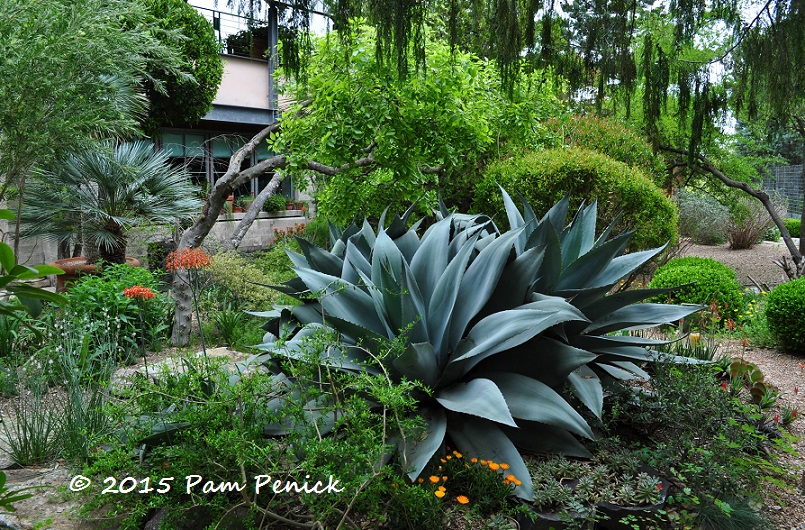
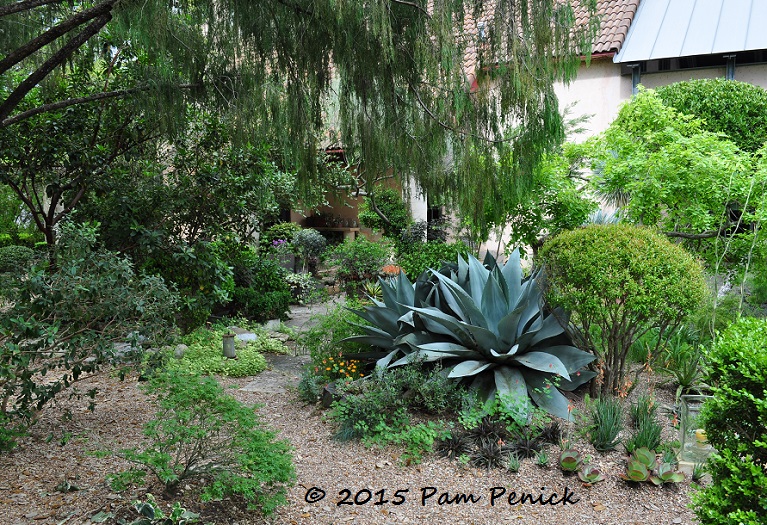
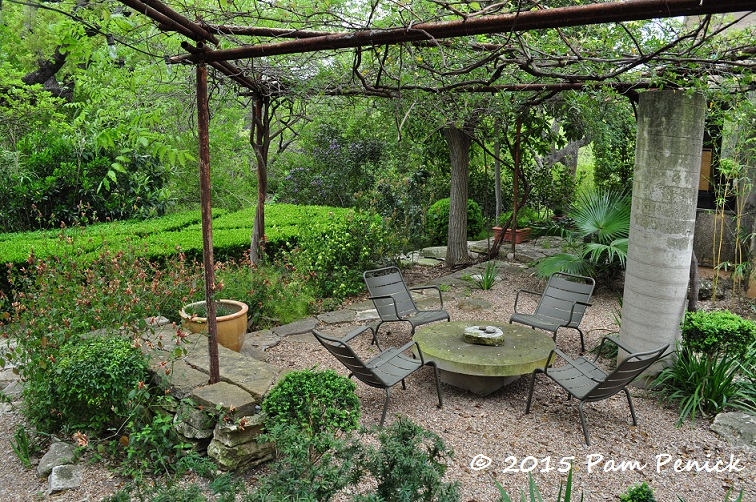
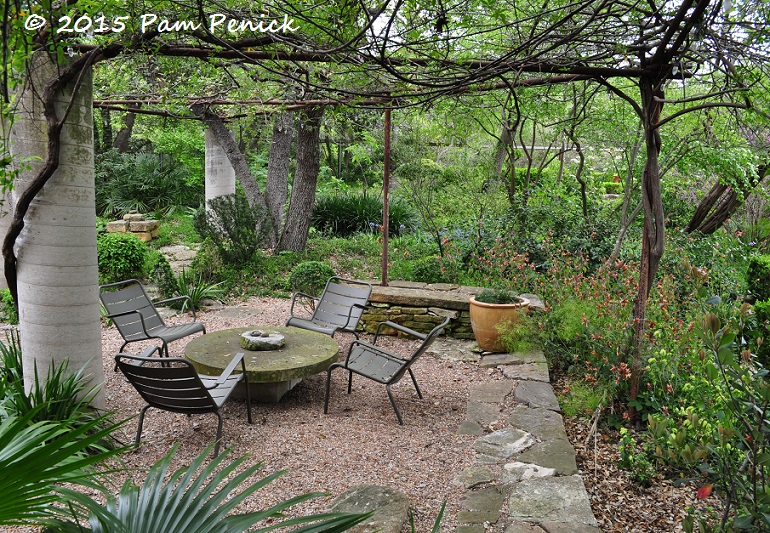
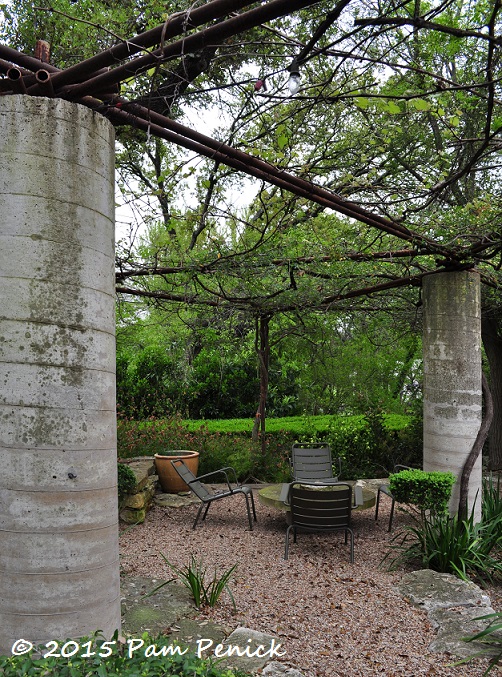
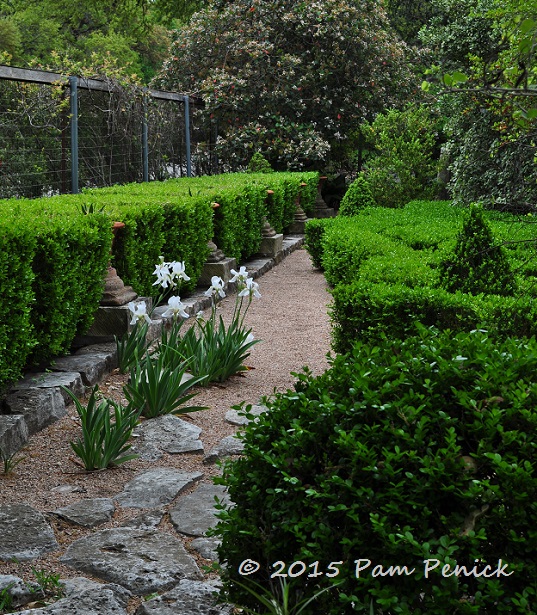
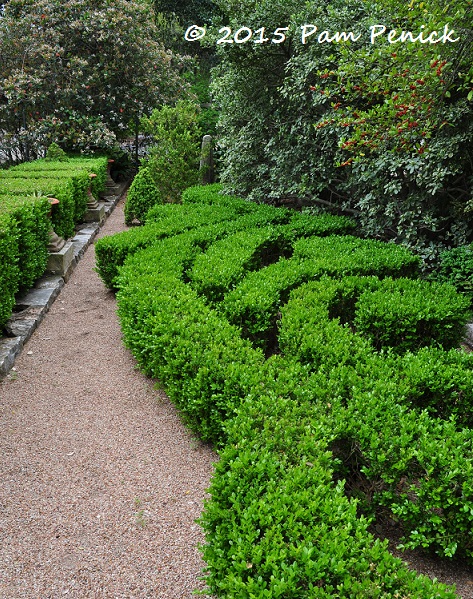
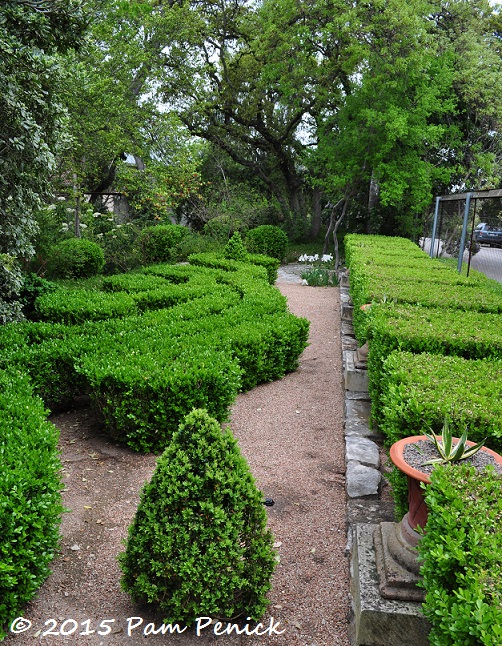
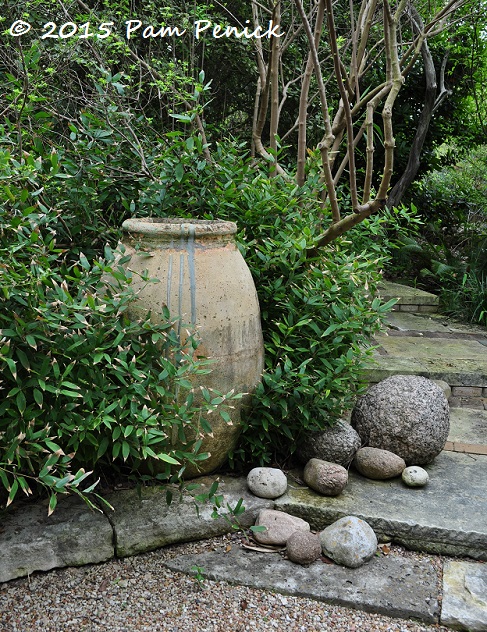
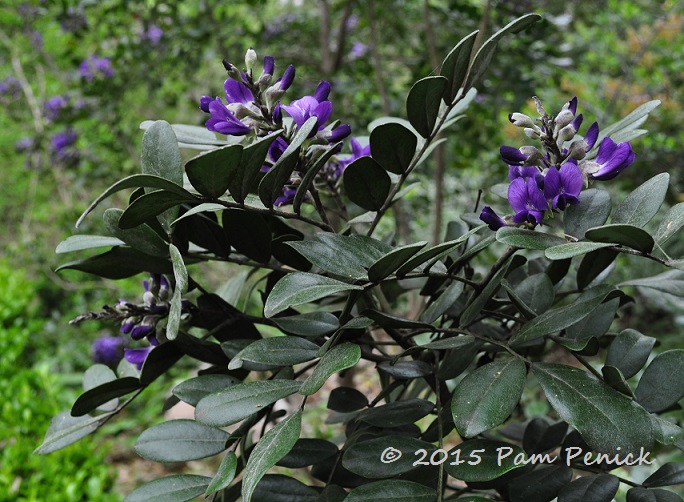
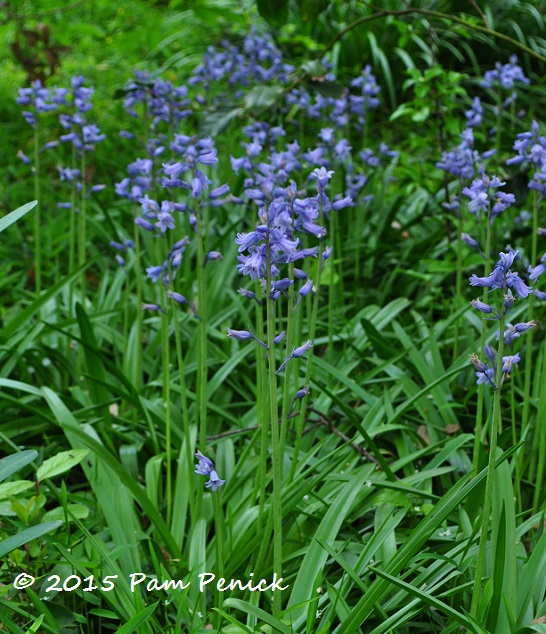
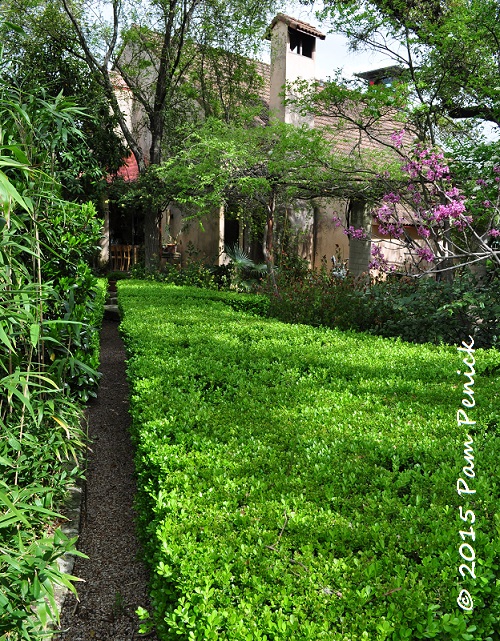
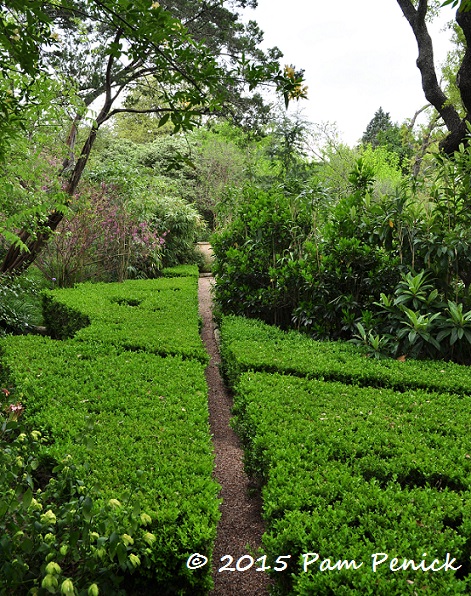
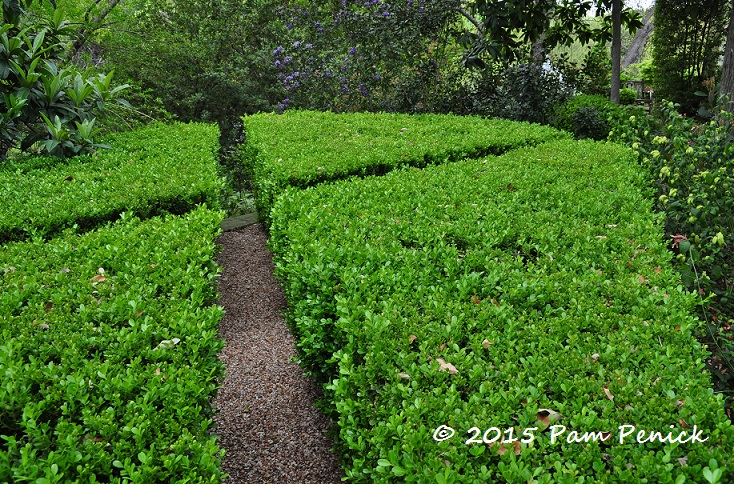
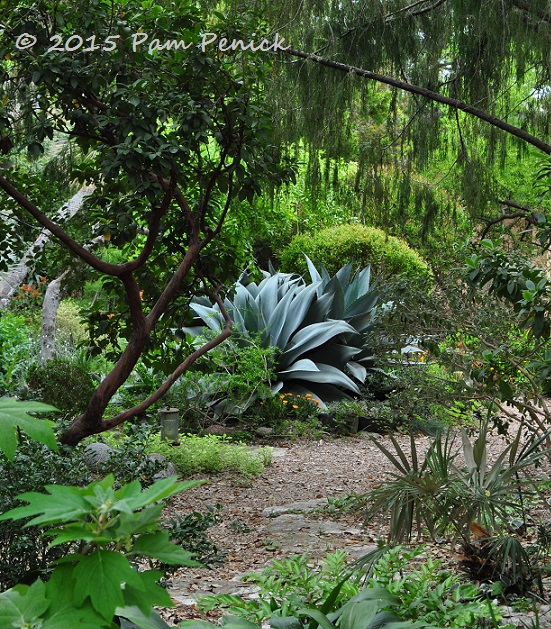
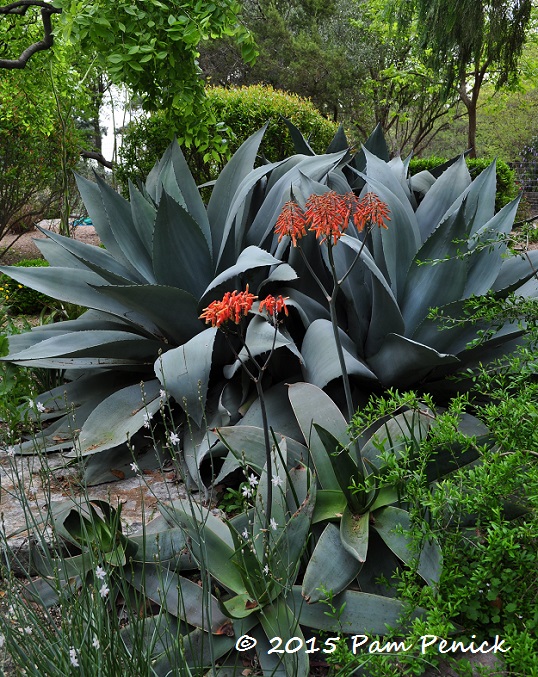
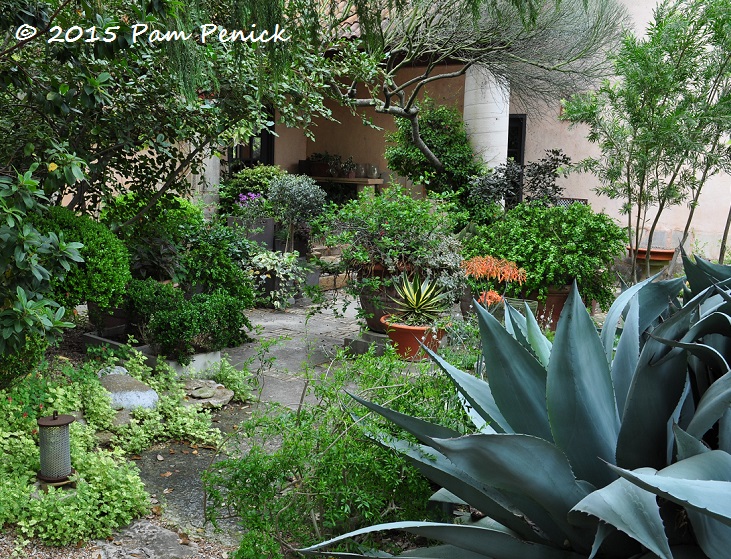
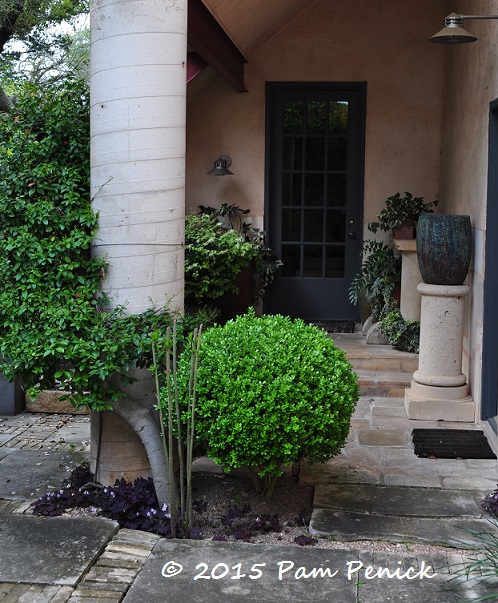
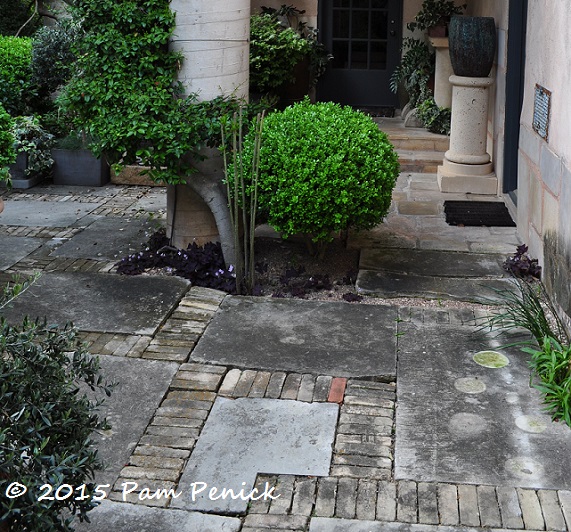
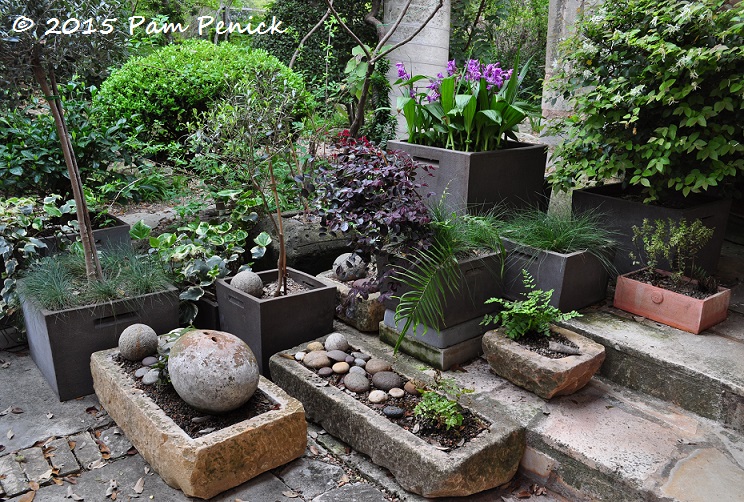
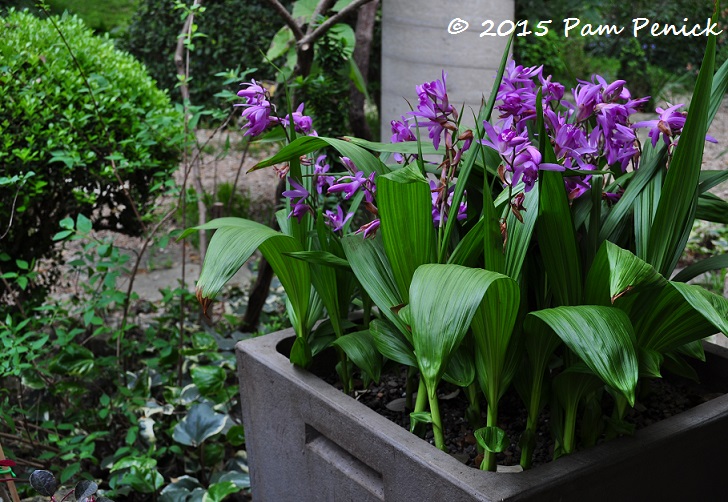
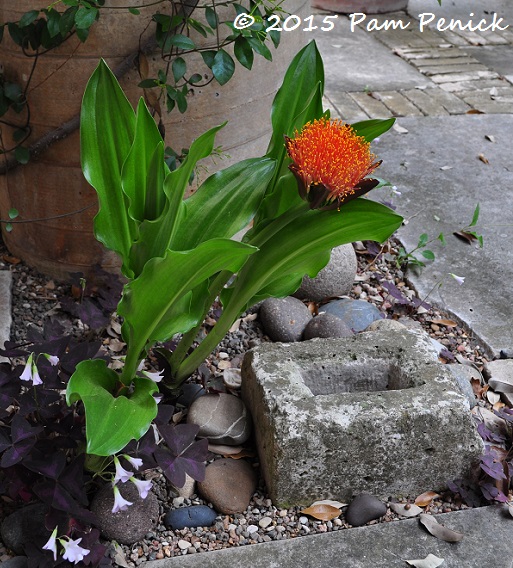
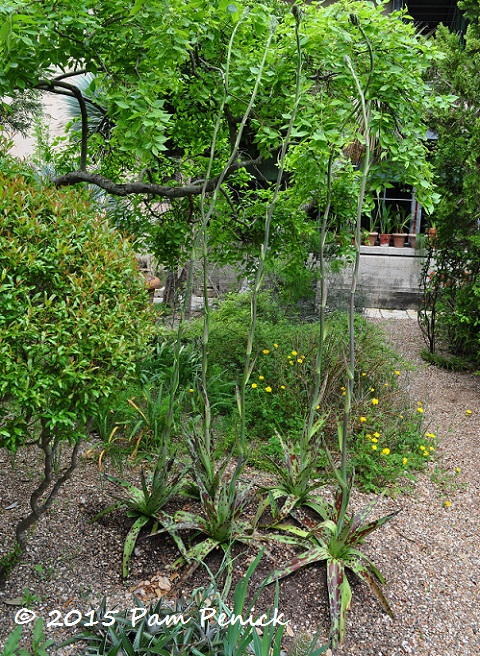
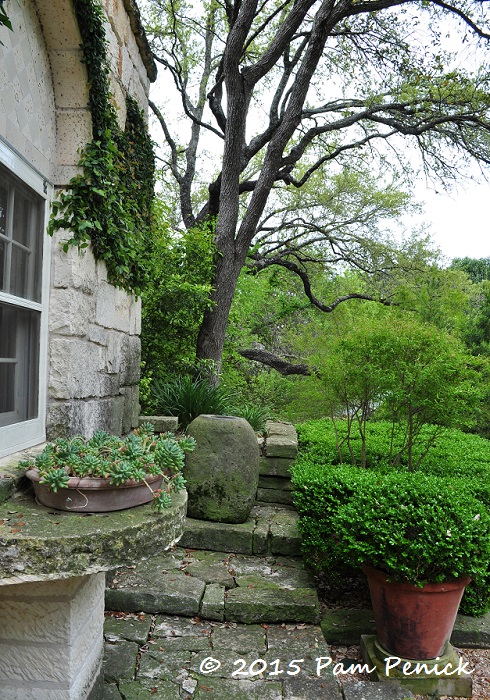
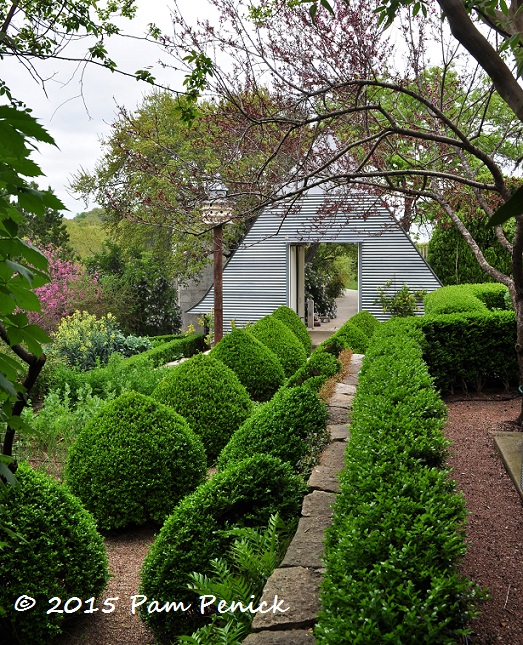
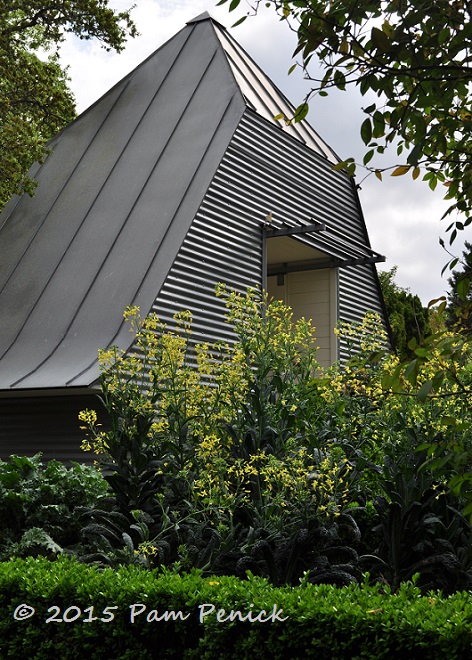
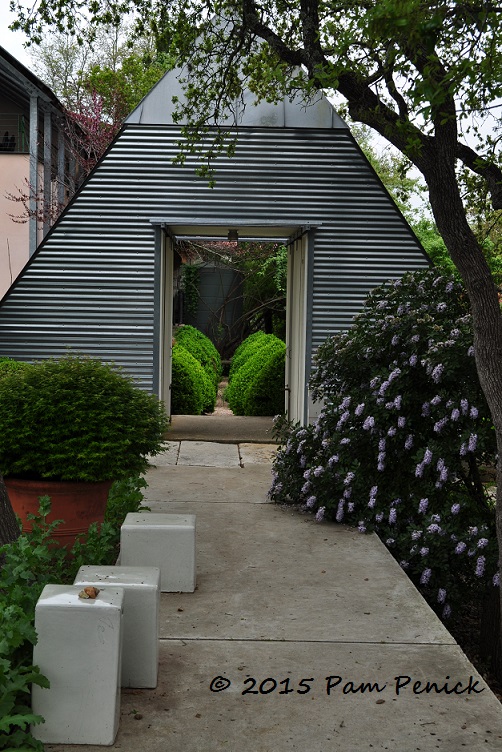
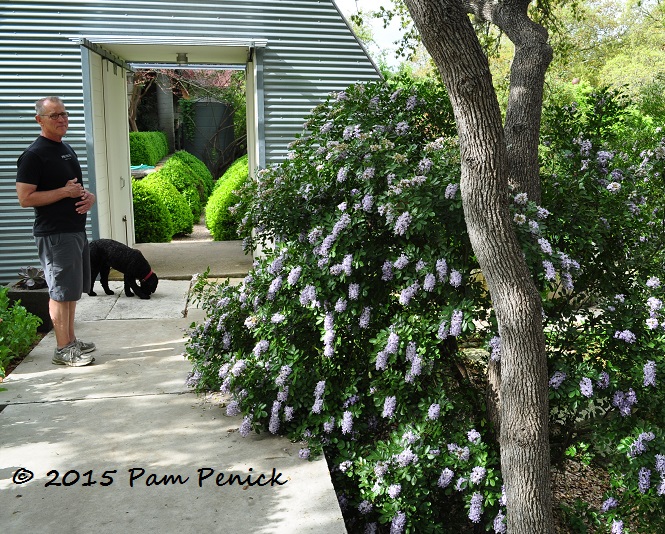
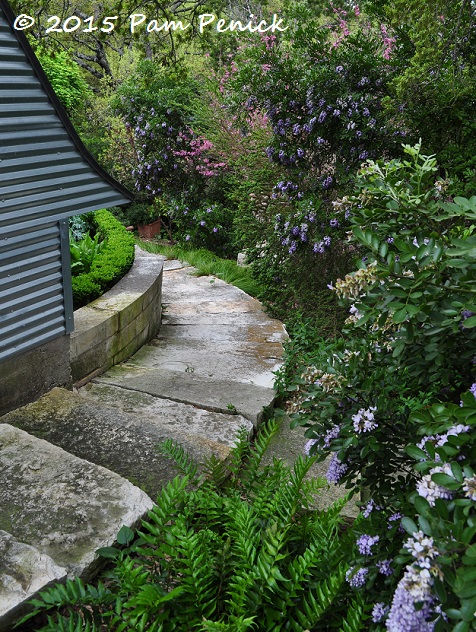
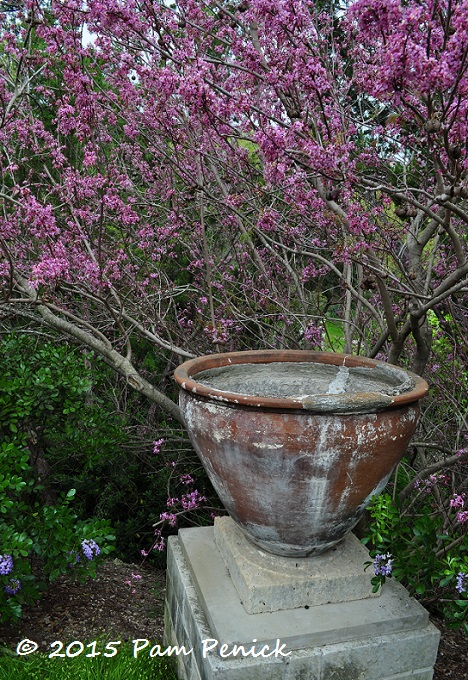
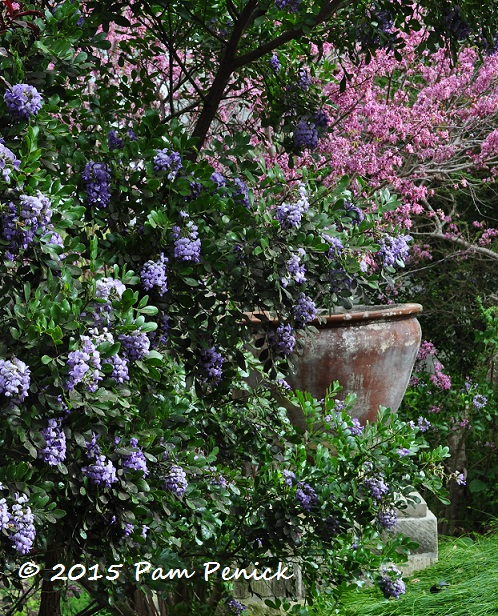
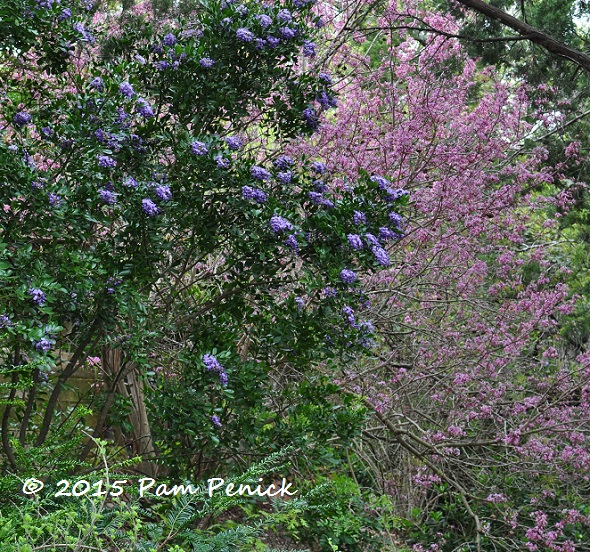
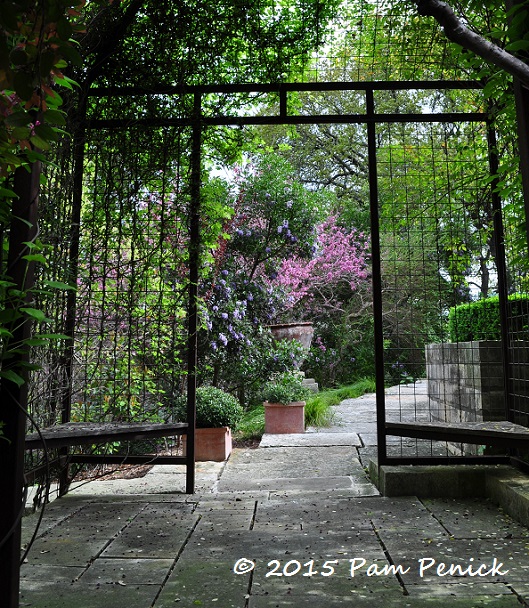
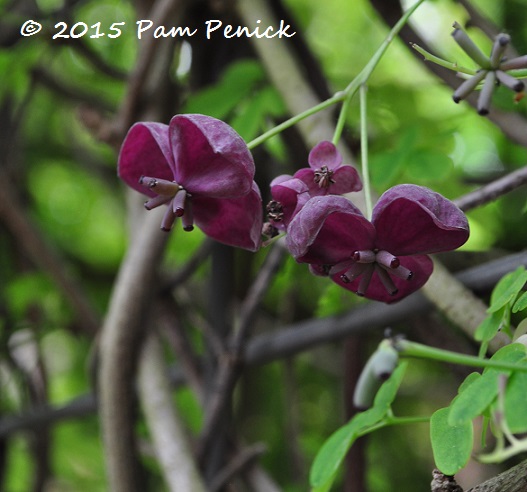
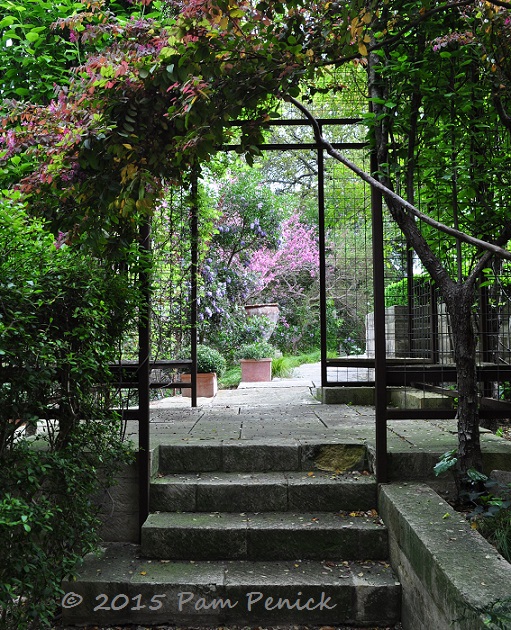
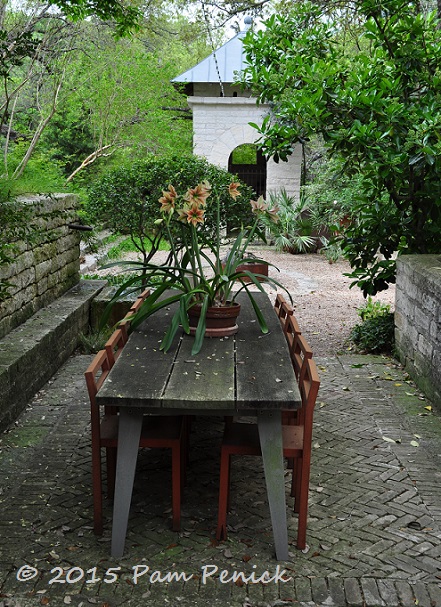
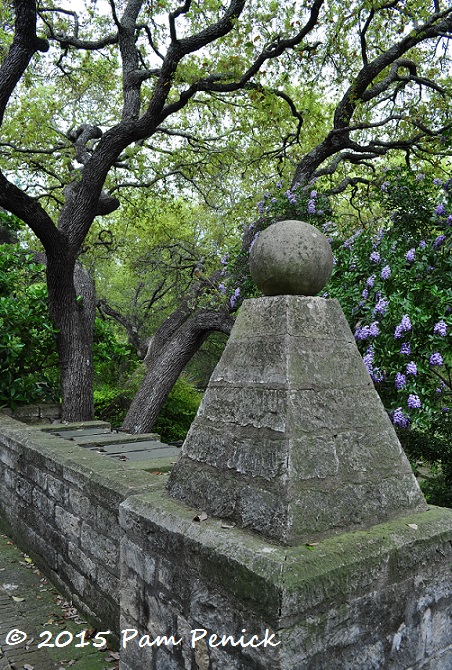
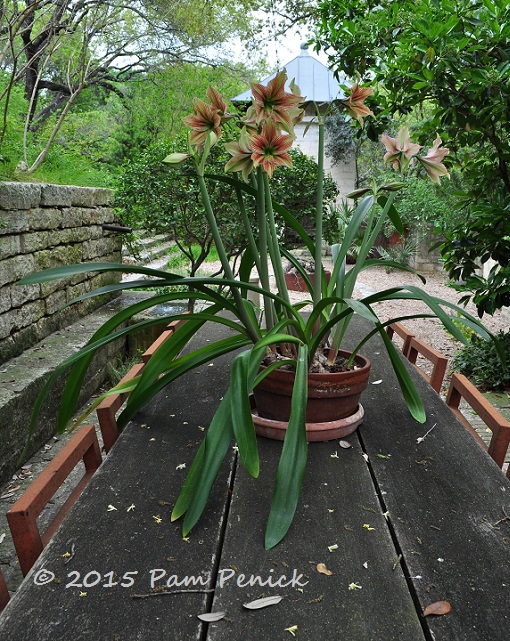
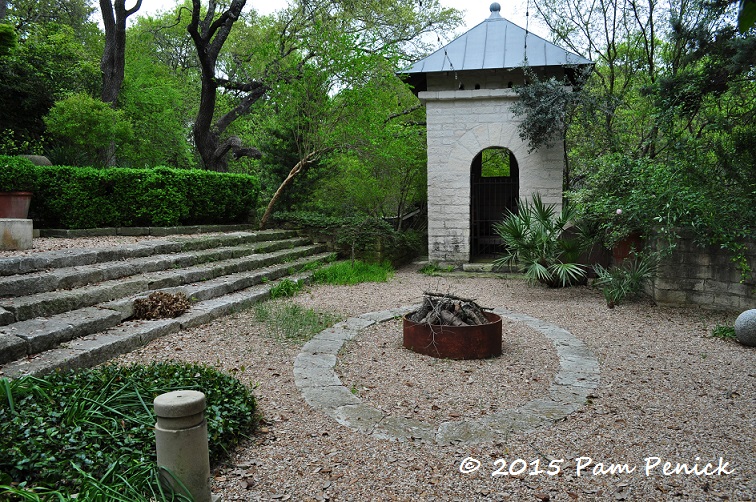
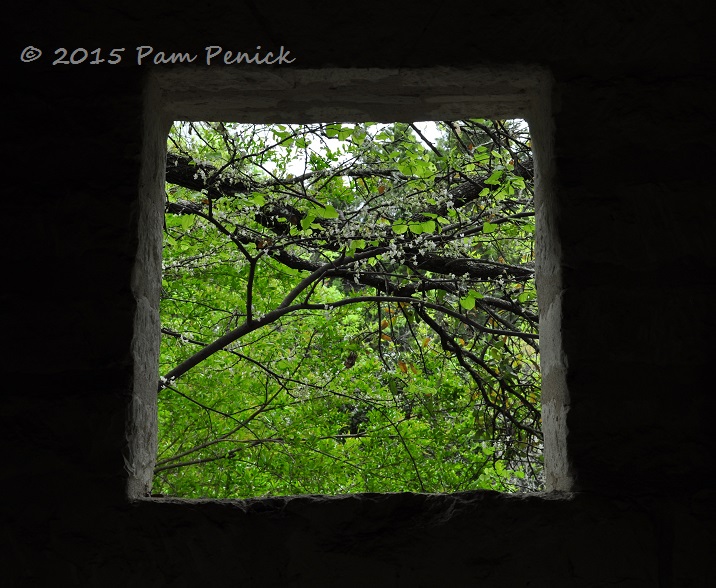
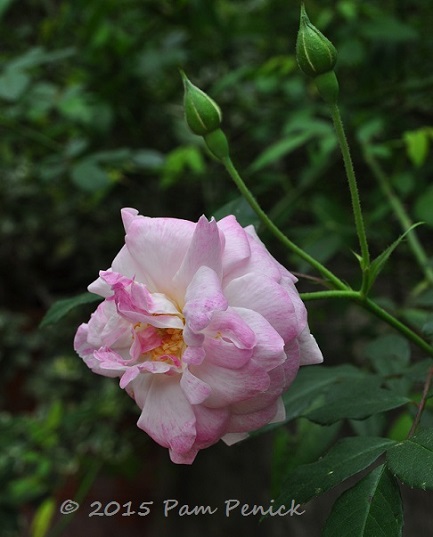
Wonderful! So many ideas. Thanks for sharing a last look.
It’s my pleasure, Cindy. —Pam
What a wonderful place, and how exciting for them to be starting a new adventure! Beautiful photos, as always…
Thanks, Deb. —Pam
Austin’s loss, indeed. It’s hard to overstate how much influence they have had on Austin’s landscape design scene. What always amazes me about this garden is how much the plant material changes each time I see it. They have been so generous in opening their garden and home over the years. This will definitely be Santa Fe’s gain.
Looking back through my earlier posts about the garden, I noticed many plant changes too, Jean. But then that’s true of all gardeners’ gardens, I suppose. There’s always something new to try or another place to move an old favorite. —Pam
What a great garden!
It truly is, Linda. —Pam
Having seen it a while ago, there are some elements that I recognize, but many more that I don’t. I love the old world feel that permeates the garden with the stones and vignettes. Let’s hope the new owners will buy it because they love the garden and are willing to be stewards of it and also willing to share it with the garden community as well.
I talked about this with James. He feels that the bones of the garden are so strong, with many evergreens that need just once a year pruning, that the garden won’t be too challenging for new owners. Obviously a garden of this scale, with a house at this price point, will require regular hired maintenance. His hope is that whoever buys it will employ a skilled gardener who knows the garden, and things can continue without much change. —Pam
How fabulous to be invited to see this garden! So much to take in. I love everything about it! I love the quote “if you love the plant you’ll find a place for it,” and the placement of pots. The use of boxwoods is so intriguing. Your photographs are wonderful. I could see you doing a whole book just on this garden. I hope they invite you to there next garden!
I’m glad you enjoyed it, Laurin. Look for part 2 soon. Also, if you search online, you’ll find a few articles and videos about the garden and the house, which is equally beautiful. —Pam
Not a protea. My guess is scadoxus:
http://www.plantdelights.com/Scadoxus-multiflorus-ssp-katherinae-for-sale/Buy-Katherines-Torch-Lily/
I just ordered one this year but mine hasn’t bloomed yet.
Thank you, Astra! I too thought South African bulb at first, but my own online search turned up nothing, so I made a second guess that didn’t seem quite right.
I think you are correct in guessing Scadoxus, but perhaps not the S. multiflorus katherine, which looks to have quite different leaves in the photos on this page: http://www.pacificbulbsociety.org/pbswiki/index.php/Scadoxus. Based on leaf and flower, I’d have to go with Scadoxus membranaceus or pseudocaulus. —Pam
It’s Scadoxus puniceus var natalensis. I was fortunate to buy one from Gardens 20 some years ago and it has set many seed over those years which have all now grown up. From that one plant I now have orange, pink, and yellow forms throughout my garden. Even 20 years later it remains a rarity in Austin, a rarity i’m fortunate to have and to cherish thanks to the trailblazing done by James and Gary. I’m even now getting requests from collectors in it’s Native South Africa for seeds from my varieties.
Sounds like you picked up a real gem all those years ago, John. Thanks for sharing the name. —Pam
Although it’s blooming a little early…still looks like a S. African bulb to me.
Yes! See my reply above. —Pam
36 years! My mind can’t even comprehend that. It’s going to take a special owner to move in and care for that garden and make it their own. I hope they can find a person to do it justice.
I imagine it’s a challenging property to sell even without the garden, just because of the price point. But what do I know? Maybe there are plenty of super-wealthy gardeners in the market for a truly beautiful Austin home. I do hope so! This garden should be loved, not just managed. —Pam
This garden sure knock off your socks. A plant persons dream space. I would love to get lost there for a few hours.
Lisa, I felt very lucky to be turned loose after the interview to wander at will and take pictures. I really appreciate James and Gary’s generosity in sharing it with me. —Pam
The garden has great structure, as well as beautiful plants. Whoever buys that property will be very lucky to gain such a garden – I wouldn’t care if it came with a shack of a house.
Right? But believe me, the house is far from shack-like. —Pam
Sensitive, creative realtor needed. So glad to have seen it at this moment, in all its glory.
So was I, Ricki. —Pam
Astra is right it is a Scadoxus Flaming Torch. They have them at Treesearch Farms. I took some pictures and they are in my blog about TSF – http://ravenscourtgardens.com/2015/03/06/a-reconnaissance-trip-to-treesearch-farms/ They are super cool in mass plantings.
Thanks for the Scadoxus confirmation, Laurin. It’s a cool-looking plant. —Pam
I am at a loss for words. I know it is selfish, but I hate for them to leave this amazing place. This is truly a garden that has evolved over time and is so beautiful and inspiring. I can look at pictures of it over and over and still be inspired by it. I do hope the new owners will appreciate it and not go in and destroy what has taken years to accomplish. I wish they would have one more tour before they leave. Thanks Pam for sharing these final pictures. I will treasure them even more now.
Malcolm
Abilene, TX
PS-I agree with one of the previous comments. This would be a great book opportunity and you certainly have the eye to capture it in its glory. I would be first in line to buy it.
Aw, thanks for the nice words, Malcolm. I’ll have more pics up in part 2 tomorrow. —Pam
I was just looking at your second post on this garden and wishing for a book to preserve this extraordinary place. In the meantime, this is bookmarked. . .
Oh, it’s so interesting to compare your pictures to my memories of the last time I was there. It seems like the boxwoods have filled in quite a bit. I never did get to see the new lower garden below the studio, so I am really curious about how that turned out.
It’s a meadowy sort of garden, Lori. Pics coming soon. —Pam
Impressive forms and mix of lines, greenery, surprise and so on. Would be hard to leave that for most anything, except something as vast and well-designed.
Well, it’s all about the process, right? That’s the exciting part. —Pam
Excellence is in the details.
Indeed, Greggo. There are many beautiful details in this garden. —Pam
Thank you for sharing this amazing garden with us, Pam. It’s absolutely wonderful. I don’t like clipped hedges, but from a design perspective I can certainly appreciate the need for that negative space and it’s definitely better than lawn. I always drool over photos of Texas mountain laurel. If I had better drainage, I would give them a try, but without that I’m afraid our wet PNW winters would do them in. I just think it’s one of the most beautiful shrubs/small trees. My Bletilla striata still bear mere buds, two months after you visited this garden. I love that Scadoxus. It’s wonderful, and I can see why you guessed protea at first.
It’s always interesting to see how climate, even though we share zone 8b (right?), affects plant bloom time, like the Bletilla you mentioned. That’s Mother Nature, keeping us on our toes! —Pam
Such great photos of an amazing garden. What a treat yesterday to get both your blog by email and Wildflower magazine by snail mail featuring your “Dry & Mighty” article on the cover. You are a very talented and busy lady!
Thanks, Nancy! I do stay pretty busy. 🙂 —Pam
Yes, a house and garden that’s book-worthy before it changes hands forever. I’ll always remember this from your earlier posts as the “eyebrow” house, when I first grasped what Texas limestone was all about.
I love those ivy-covered “eyebrows” too, Denise. I wish I’d gotten a good picture of them for this post. —Pam
Even though I’ve not seen their garden since our Fling visit, for some reason I’m deeply saddened by their move to New Mexico. Thank you so very much for documenting this special place one last time for us to savor its magic over and over.
Perhaps it makes you sad to think about leaving a garden you’ve put that much of yourself into? I can understand that. I can also see it from their point of view: moving on to a new adventure and creating a new garden. I tend to the latter feeling myself. Seeing someone else leave is always harder than being the one doing the leaving. —Pam